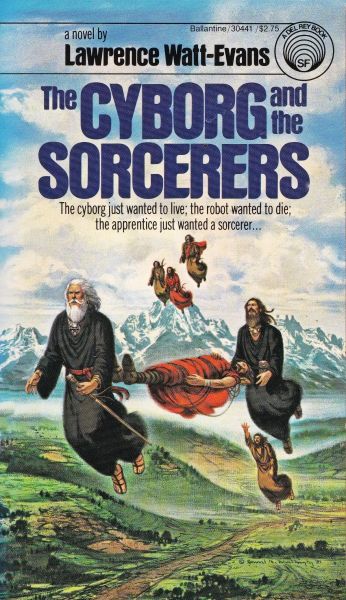Play Their Fantasy
The Cyborg and the Sorcerers (War Surplus, volume 1)
By Lawrence Watt-Evans

7 Mar, 2024
1982’s The Cyborg and the Sorcerers, also published as The Cyborg and the Sorceress, is the first volume in Lawrence Watt-Evans’ War Surplus science-fantasy duology.
Six months after a cyborg, Slant, was dispatched to infiltrate and reconnoiter rebel planets, the rebel alliance’s ships pierced Solar defenses and obliterated Earth and Mars. Whether this means that the rebels won is unclear. What is clear is that Earth lost… decisively.
Slant is programmed to carry out his mission despite the fall of Earth.
Interstellar travel is (comparatively) cheap and easy1. It is not fast. There being no end run around the speed of light, starships traverse interstellar distances at relativistic velocities. By the clocks on his starship, the war ended fifteen years ago. According to planetary clocks, it has been over three centuries.
Earth did not entirely trust its cyborg volunteers. They planted a bomb in Slant’s head, one that they assured him would kill him painfully if detonated. As a further security measure, Slant’s starship’s computer can and will detonate the bomb if Slant deviates from mission parameters (in the opinion of the computer). There is an override command that would (non-fatally) end Slant’s tour of duty. Too bad that Earth can no longer send it. Too bad the computer believes that its purpose is to die and is relentlessly seeking a pretext to destroy itself and kill the cyborg.
Slant’s next target system has two worlds, a Mars-like world whose installations are three centuries dead and Earthlike Dest, whose humans survived the nuclear attack that wrecked their civilization. It is clear from orbit that the planet has reverted to barbarism… so why is the computer insisting it can detect highly-advanced enemy activity down on Dest’s surface?
Slant’s initial forays confirm that Dest is limited to pre-industrial technology. Further investigation reveals wide-spread belief in magic, not unexpected on a backward world. What is unexpected is that the magic is very much real. Adepts can alter reality by will alone2.
The computer is determined to protect long-fallen Earth by discovering the secret of magic. Slant comes to believe that the sorcerers may hold the key to his freedom… provided that the computer does not realize what Slant is up to. If the computer does, that bomb in Slant’s head will detonate. Also, as previously mentioned, the computer is suicidal. The machine relentlessly seeks out ways to implement orders in ways that can justify its (and Slant’s) destruction. If it can take the local civilization with it? So much the better.
~oOo~
It seems to be the Fall of Interstellar Empires Week here at James Nicoll Reviews.
This wasn’t actually one of the LWE (Lawrence Watt-Evans) books whose reviews were commissioned but since the first one I reviewed was fantasy and the second one was science fiction, reviewing a science fantasy was irresistible.
This is an early LWE and it shows. The plot is repetitive, mainly consisting of Slant encountering locals, having possible liberation dangled in front of him, then being forced by the computer to slaughter said unfortunate locals. Magic is pretty sweet but it’s no match for submachine guns and disintegrators. Much of the book consists of back and forth between Slant and his computer. There is one significant woman character.
In many ways, this novel feels more venerable than it actually is. One can imagine it being serialized in Campbell’s Analog or even Astounding. I suppose this isn’t surprising. 1982 is much closer to 1962 or even 1952 than it is 2024. I am not sure how that came to be. It didn’t seem to be true back in 1982, when this novel was bright and shiny.
On the plus side, older publishing custom (brevity) compels brisk action. With fewer than 250 pages available, LWE has no room to waste. The plot moves forward at a pace from which modern authors could learn. Also, despite the existence of a sequel, the novel is entirely self-contained. Cyborg is an entertaining way to spend an evening.
The Cyborg and the Sorcerers is available here (Amazon US), here (Amazon Canada), here (Amazon UK), here (Apple Books), here (Barnes & Noble), and here (Words Worth Books)
I did not find The Cyborg and the Sorcerers at Chapters-Indigo (or Kobo, for that matter).
1: It’s heartening to see that even a rudimentary grasp of rocket science can undermine one’s enjoyment of old time SF. Cyborg hails from the era when relativistic star flight was easy-peasy, requiring only a decent nuclear rocket and suitable reaction mass. The math, being no respecter of narrative needs, says that zipping around at near-light speeds, is far more difficult. Curse that rocket equation! Clearly the starships in this book have some way to circumvent mass ratios.
On that note, I am just going to assume that the lacunae in Slant’s grasp of the big picture extends to the cause of the war. He claims it is because the colonies stopped sending food to Earth. Either that involved small amounts of luxury foods, spices and the sort, or Slant misunderstood or was lied to. There is no way that shipping bulk goods at near-light speeds makes sense.
That said, this would not be the only sublight empire with dubious economics published circa 1980. Downbelow Station implies that the pre-FTL extrasolar colonies imported food from Earth before Downbelow was discovered.
2: Magic is achieved sometimes by will alone and sometimes requires various material components as well.
